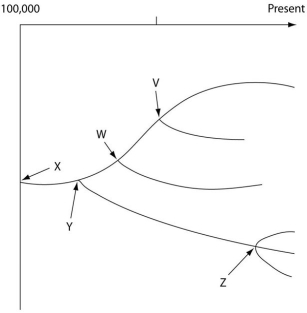A) easily reached and heterogeneous.
B) isolated and heterogeneous.
C) isolated and homogeneous.
D) isolated and extremely cold.
E) easily reached and homogeneous.
G) A) and E)
Correct Answer

verified
Correct Answer
verified
Multiple Choice
Which of the following concepts/ideas reflects Lamarck's perception of evolution?
A) tree of life
B) traits must be heritable
C) use and disuse
D) natural selection
E) artificial selection
G) A) and B)
Correct Answer

verified
Correct Answer
verified
Multiple Choice
What is true of pseudogenes?
A) They are composed of RNA, rather than DNA.
B) They are the same things as introns.
C) They are unrelated genes that code for the same gene product.
D) They are vestigial genes.
F) None of the above
Correct Answer

verified
Correct Answer
verified
Multiple Choice
In contrast to Cuvier's ideas,geologists James Hutton and Charles Lyell,proposed that earth's geological features could be explained by
A) slow, gradual processes over time.
B) evolution.
C) island biogeography
D) natural catastrophes.
E) the design of the earth's Creator.
G) A) and C)
Correct Answer

verified
Correct Answer
verified
Multiple Choice
Ichthyosaurs were aquatic dinosaurs.Fossils show us that they had dorsal fins and tails,as do fish,even though their closest relatives were terrestrial reptiles that had neither dorsal fins nor aquatic tails.The dorsal fins and tails of ichthyosaurs and fish are
A) homologous.
B) examples of convergent evolution.
C) adaptations to a common environment.
D) Three of the responses above are correct.
E) Two of the responses above are correct.
G) C) and D)
Correct Answer

verified
Correct Answer
verified
Multiple Choice
Which of the following statements about natural selection is a misconception?
A) Natural selection involves differential reproductive success.
B) Natural selection occurs when individuals evolve.
C) In natural selection, traits that are favoured depend on current environmental conditions.
D) Natural selection occurs as a result of competition among individuals in a population.
E) Natural selection acts on heritable variations in a population.
G) B) and E)
Correct Answer

verified
Correct Answer
verified
Multiple Choice
The following questions refer to the description below. You have read that soapberry bugs,Jadera haematoloma,adapt to available food sources.For example,in southern Florida,soapberry bugs feed on seeds of a native plant,the balloon vine.In central Florida,the balloon vine is rare and soapberry bugs have switched to eating seeds of an introduced species,the goldenrain tree.The seeds of the goldenrain tree fruits are much closer to the fruit surface than the seeds of the native balloon vine fruit.As a result,natural selection results in beaks that are shorter in soapberry bugs that utilize goldenrain tree fruits than those that feed on balloon vine fruit seeds. -A conservation organization has been trying to eliminate introduced species and encourage the growth/spread of native species.After several years,the balloon vine has almost totally replaced the goldenrain tree in the experimental plot.Based on your knowledge of evolution,which of the following outcomes would appear to be the most logical?
A) Half of the soapberry bugs will die.
B) To save soapberry bugs with short beaks, the researchers must relocate them to a different plot.
C) Intermediate beak length will be favoured just in case the introduced goldenrain tree makes a comeback.
D) The genes for short beaks will be lost.
E) Variation in beak size will remain present in the soapberry bug population, but natural selection will favour beak lengths that are best adapted to the current food source.
G) None of the above
Correct Answer

verified
Correct Answer
verified
Multiple Choice
During a study session about evolution,one of your fellow students remarks,"The giraffe stretched its neck while reaching for higher leaves; its offspring inherited longer necks as a result." Which statement is most likely to be helpful in correcting this student's misconception?
A) Characteristics acquired during an organism's life are generally not passed on through genes.
B) Spontaneous mutations can result in the appearance of new traits.
C) Only favourable adaptations have survival value.
D) Disuse of an organ may lead to its eventual disappearance.
E) If the giraffes did not have to compete with each other, longer necks would not have been passed on to the next generation.
G) A) and C)
Correct Answer

verified
Correct Answer
verified
Multiple Choice
DDT was once considered a "silver bullet" that would permanently eradicate insect pests.Today,instead,DDT is largely useless against many insects.Which of these would have been required for this pest eradication effort to be successful in the long run?
A) Larger doses of DDT should have been applied.
B) All habitats should have received applications of DDT at about the same time.
C) The frequency of DDT application should have been higher.
D) None of the individual insects should have possessed genomes that made them resistant to DDT.
E) DDT application should have been continual.
G) B) and D)
Correct Answer

verified
Correct Answer
verified
Multiple Choice
The following questions refer to the figure below,which shows an outcrop of sedimentary rock whose strata are labelled A-D.
 -Currently,two extant elephant species (X and Y) are placed in the genus Loxodonta and a third species (Z) is placed in the genus Elephas.Assuming this classification reflects evolutionary relatedness,which of the following is the most accurate phylogenetic tree?
-Currently,two extant elephant species (X and Y) are placed in the genus Loxodonta and a third species (Z) is placed in the genus Elephas.Assuming this classification reflects evolutionary relatedness,which of the following is the most accurate phylogenetic tree?
A) ![]()
B) ![]()
C) ![]()
D) ![]()
E) ![]()
G) None of the above
Correct Answer

verified
Correct Answer
verified
Multiple Choice
Which of these conditions should completely prevent the occurrence of natural selection in a population over time?
A) All variation between individuals is due only to environmental factors.
B) The environment is changing at a relatively slow rate.
C) The population size is large.
D) The population lives in a habitat where there are no competing species present.
F) A) and D)
Correct Answer

verified
Correct Answer
verified
Multiple Choice
Which of the following must exist in a population before natural selection can act upon that population?
A) genetic variation among individuals
B) variation among individuals caused by environmental factors
C) sexual reproduction
D) Three of the responses are correct.
E) Two of the responses are correct.
G) A) and B)
Correct Answer

verified
Correct Answer
verified
Multiple Choice
In the mid-1900s,the Soviet geneticist Lysenko believed that his winter wheat plants,exposed to ever-colder temperatures,would eventually give rise to ever more cold-tolerant winter wheat.Lysenko's attempts in this regard were most in agreement with the ideas of
A) Cuvier.
B) Hutton.
C) Lamarck.
D) Darwin.
E) Lyell.
G) A) and E)
Correct Answer

verified
Correct Answer
verified
Multiple Choice
Cuvier,a French scientist,noted that the older the strata,the more dissimilar the fossils in it were,compared to current life forms.He also observed the appearance and disappearance of species.Cuvier proposed that the differences among fossils and species extinctions were a result of
A) evolution.
B) catastrophic events.
C) competition between species.
D) the origin of new species.
E) natural selection.
G) D) and E)
Correct Answer

verified
Correct Answer
verified
Multiple Choice
Over evolutionary time,many cave-dwelling organisms have lost their eyes.Tapeworms have lost their digestive systems.Whales have lost their hind limbs.How can natural selection account for these losses?
A) Natural selection cannot account for losses, only for innovations.
B) Natural selection accounts for these losses by the principle of use and disuse.
C) Under particular circumstances that persisted for long periods, each of these structures presented greater costs than benefits.
D) The ancestors of these organisms experienced harmful mutations that forced them to find new habitats that these species had not previously used.
F) A) and C)
Correct Answer

verified
Correct Answer
verified
Multiple Choice
The following questions refer to the figure below,which shows an outcrop of sedimentary rock whose strata are labelled A-D.
 -If x indicates the fossils of two closely related species,neither of which is extinct,then their remains may be found in how many of these strata?
-If x indicates the fossils of two closely related species,neither of which is extinct,then their remains may be found in how many of these strata?
A) one stratum
B) two strata
C) three strata
D) four strata
F) A) and B)
Correct Answer

verified
Correct Answer
verified
Multiple Choice
The following questions refer to the description below. You have read that soapberry bugs,Jadera haematoloma,adapt to available food sources.For example,in southern Florida,soapberry bugs feed on seeds of a native plant,the balloon vine.In central Florida,the balloon vine is rare and soapberry bugs have switched to eating seeds of an introduced species,the goldenrain tree.The seeds of the goldenrain tree fruits are much closer to the fruit surface than the seeds of the native balloon vine fruit.As a result,natural selection results in beaks that are shorter in soapberry bugs that utilize goldenrain tree fruits than those that feed on balloon vine fruit seeds. -Within six months of effectively using methicillin to treat S.aureus infections in a community,all new infections were caused by MRSA.How can this result best be explained?
A) S) aureus can resist vaccines.
B) A patient must have become infected with MRSA from another community.
C) In response to the drug, S. aureus began making drug-resistant versions of the protein targeted by the drug.
D) Some drug-resistant bacteria were present at the start of treatment, and natural selection increased their frequency.
E) The drug caused the S. aureus DNA to change.
G) D) and E)
Correct Answer

verified
Correct Answer
verified
Multiple Choice
Natural selection is based on all of the following except
A) genetic variation exists within populations.
B) the best-adapted individuals tend to leave the most offspring.
C) individuals who survive longer tend to leave more offspring than those who die young.
D) populations tend to produce more individuals than the environment can support.
E) individuals adapt to their environments and, thereby, evolve.
G) A) and E)
Correct Answer

verified
Correct Answer
verified
Multiple Choice
The following questions refer to the evolutionary tree shown below.
The horizontal axis of the cladogram depicted below is a timeline that extends from 100 000 years ago to the present; the vertical axis represents nothing in particular.The labelled branch points on the tree (V-Z) represent various common ancestors.Let's say that only since 50 000 years ago has there been enough variation between the lineages depicted here to separate them into distinct species,and only the tips of the lineages on this tree represent distinct species.
 -According to this tree,what percentage of the species seem to be extant (in other words,not extinct) ?
-According to this tree,what percentage of the species seem to be extant (in other words,not extinct) ?
A) 25%
B) 33%
C) 50%
D) 66%
E) 75%
G) C) and E)
Correct Answer

verified
Correct Answer
verified
Multiple Choice
Logically,which of these should cast the most doubt on the relationships depicted by an evolutionary tree?
A) None of the organisms depicted by the tree ate the same foods.
B) Some of the organisms depicted by the tree had lived in different habitats.
C) The skeletal remains of the organisms depicted by the tree were incomplete (in other words, some bones were missing) .
D) Transitional fossils had not been found.
E) Relationships between DNA sequences among the species did not match relationships between skeletal patterns.
G) C) and D)
Correct Answer

verified
Correct Answer
verified
Showing 41 - 60 of 68
Related Exams